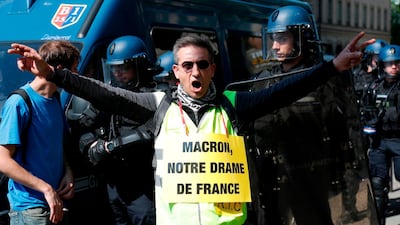The understandable first instinct after a fire is to restore exactly what was lost. Such an endeavour serves to redress some of the tragedy and loss from such an incident. Often, however, it competes with the strong desire of each generation to surpass its predecessors.
In the aftermath of the blaze which enveloped Notre-Dame cathedral last Monday, and which almost destroyed a World Heritage monument visited by 13 million people a year, this battle of choices is playing out now. The French government last week launched a competition to involve architects in the rebuilding of Notre-Dame, which was last reconstructed in the middle of the 19th century.
The added twist is that an embattled Emmanuel Macron seems determined to use the situation to redeem himself as president.
On one level, there is nothing new in the grand scheme. Faced with the challenge of rebuilding the Houses of Parliament in London after a devastating fire in the 1830s, a competition was launched to design the landmark site.
What emerged was the now-familiar building in the Gothic revival style, alongside Big Ben's clock tower, an iconic design that is instantly recognisable around the world.
And when St Paul's Cathedral was gutted in the Great Fire of London in 1666, the decision was taken to abandon the similarly medieval style. Sir Christopher Wren’s design might not have won favour immediately with everyone – opinions ranged from "unrestrained delight" to sneers about an "unfamiliar, un-English...air of Popery" – but today it remains one of the most visited attractions in the capital.
There is, therefore, previous form for a reimagining of history. So far, the French response has been a classic in disaster management. It has also triggered a predictable backlash.
Projects like the one now underway in Paris are always hotly contested.
The row over New York’s World Trade Centre post 9/11 is a case in point. A fierce campaign was waged to rebuild the twin towers exactly as they were. It was unsuccessful. Anyone visiting the memorial and surrounding area today can appreciate how inappropriate that would have been.
Paris has used radical designs in renovating traditional buildings in the face of conservative opposition. IM Pei, the architect behind the Louvre revamp in the 1980s, said 90 per cent of Parisians were initially against his glass pyramid addition to the courtyard.
Right-wing commentators are suspicious that there will be an attempt to foist a secular or multi-faith “place of the people” element onto the new Notre-Dame structure. Jordan Bardella, a spokesman for the National Rally (formerly known as the National Front), has demanded “absolute respect for the national heritage”.
Voices demanding the return of the wooden roof and spire are clamouring to be heard. “It’s an emblematic building that should recover its identity,” said Francois de Maizieres, the mayor of Versailles, who added that modernity had no place in the project.
Other arguments are threatening to sideline architecture for wider divisions tearing apart France and much of Europe.
From the first hours of the inferno, Mr Macron was anxious to appear presidential, vowing to rebuild even as flames were still licking at the spire. Ideas about harnessing a wave of youth creativity are also swirling around the Elysee Palace, including talk of a nationwide cadre of craftspeople and technicians with the skills to work on public projects.
For a president already firefighting on the home front, this is an opportunity to prove his mettle. He is already contemplating the break up of the elite colleges that produce the so-called enarque class of administrators that rule the country. How convenient to create a flip side for the masses with the establishment of a working-class vanguard to mobilise behind a national cause.
France has spent too many decades neglecting the ambitions of its younger generation. It may be that the recent marathon Great Debate that Mr Macron conducted throughout France highlighted a deficit of potential. For a nation in search of a new direction, Notre-Dame's fate can be viewed as part of a wider search for greater public spirit.
It serves a purpose for Mr Macron. Not just a church in ruins, Notre-Dame represents a platform to prove France is a place of achievement and is ripe to become a political hobby horse. In just a few days, it has emerged as a new frontline in social media-fuelled culture wars that he must negotiate.
A misrepresented picture, for example, claimed to show Mr Macron and his prime minister openly laughing in the ruins of church. They committed no such offence but the accusatory post was disseminated to millions of people.
Another popular theme is that there have been hundreds of churches vandalised in France in recent years. The inference is that no one really cares about a religion under siege.
In contrast to nearly €1 billion that has poured into the reconstruction fund, there are said to be no resources for the neglected churches. Facebook and Twitter have been rife with memes comparing the two situations.
Distorted reactions to big events are the product of uncertain times. Notre-Dame was a disaster made for this era.

